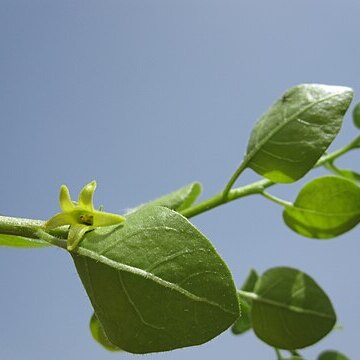Shrubs, glabrous or pubescent. Leaves alternate, or opposite on flowering stems, simple, entire, petiolate. Flowers solitary or in clusters, axillary, bisexual, actinomorphic. Calyx campanulate, 5-lobed, persistent and inflated in fruit; lobes triangular. Corolla campanulate, 5-lobed; lobes valvate in bud. Stamens 5, equal in height, inserted near base of corolla-tube; anthers bilocular, cohering, dehiscing by longitudinal slits. Ovary bilocular. Fruit a semi-succulent berry, enclosed by inflated calyx. Seeds disc-shaped to almost reniform.
Stamens 5(7), ± equal, inserted near the base of the corolla tube, included or scarcely exserted; filaments subulate often from a flat-expanded base, glabrous or minutely glandular-scaly at the base and with fringes on the back; anthers ± oblong in outline, straight, as long as or shorter than the filaments, free or sometimes conniving, attached on the lower part of the back or at the base between the thecae, dehiscing by longitudinal slits.
A genus allied to Physalis, with c. 10 species widely distributed in warm and temperate regions of the Old World extending from Mediterranean Europe southwards to the Cape of South Africa, and eastwards from the Canary and Cape Verde Islands through the Mediterranean region and Arabia to India and Sri Lanka. Hunziker, loc. cit. (2001), includes a further 9 species formerly in Physaliastrum Makino from more humid areas in eastern Asia.
Calyx almost as long as the corolla tube, campanulate, 5(7)-fid; lobes as long as or shorter than the tube, subulate upwards, not conniving at the apex, with valvate aestivation; in fruit ± enlarged and bladdery-inflated simulating Physalis, closely or loosely concealing it, reticulate, papyraceous, scarious or elsewhere coriaceous.
Ovary 2-locular, the ovules hemicampylotropous, numerous in each locule on a placenta adnate to the dissepiment; style as long as or slightly longer than the filaments, subulate, straight; stigma capitate, sometimes shortly and widely 2-lobed at the tip, included or scarcely exserted.
Seeds numerous, compressed, sub-orbicular or ± reniform; testa somewhat leathery, reticulate-foveate; embryo strongly curved, flattened, in the fleshy and scanty endosperm; radicle long, ± terete; cotyledons slender, semi-terete or linear in outline.
Corolla white to yellow or ± greenish, campanulate, often narrowly so, sometimes infundibular or sub-rotate, hairy; tube hairy inside; limb broad, (3)5(7)-fid or-lobed, somewhat reflexed, with valvate aestivation.
Leaves solitary, alternate, the upper ones usually in pairs (or whorls of 3), one larger than the others, appearing opposite (or verticillate), petiolate, entire to lobed.
Inflorescences of few–several flowers in axillary fascicles, rarely reduced to one flower; pedicels short or obsolete, often drooping in fruit.
Disk annular, adnate to and surrounding the basal part of the ovary, subentire to crenulate, slightly glandular, sometimes none.
Flowers actinomorphic, bisexual or elsewhere rarely unisexual in dioecious plants.
Shrubs or perennial herbs, ± clothed with branched hairs to subglabrous.
Fruit baccaceous, ± sessile, globose, juicy, 2-locular.

